Best Headphones for Filmmakers
Whether recording sound in the field, monitoring your audio on set, mixing audio in your music studio or editing audio as part of your film port-production – you need great headphones.
All these activities have pretty much the same requirements. The headphones I use for location sound for my films AKG K271 Studio (which I bought over 20 years ago) I actually bought for my home music studio when I was a composer. They still work as they did when I bought them – just need to replace those foam pads sometime.
Before that we had the absolute classic Beyerdynamic DT100 headphones. They were solid and heavy duty and the BBC standard issue headphones at the time. One of the features which those working in audio need is the flat response. We also had Yamaha NS-10s for the same reason.
When you are listening to music for pleasure, you might want bass or top end embellished. But when you are working in audio, especially music and sound design for film, you are better off working with headphones and speakers with a neutral audio performance. This gives you a better chance of creating a mix which suits all performance situations.
For example, if your headphones are adding bass, then you might compensate by reducing bass in your mix, meaning the final master comes out bass-light. And someone who plays it on their system with a weaker bass response goes “where’s the bass?”
Whereas with headphones for mixing you want a flat and true response, with live location recording headphones tend to be more about isolation, durability, and reproducing decently well something sonically simple like the human voice.
It’s difficult to go wrong when you choose equipment used by 1000s of industry professionals, in studios and on location, over decades. This is more true of audio equipment, which ages better than video equipment.
Why does Impedance matter?
Most headphones with low impedance (under 50 ohm) require little power to deliver high audio levels. For example, weak amplification devices like portable music players, smartphones, and other portable devices. Higher impedance headphones require more power to use at their peak performance. Put simply, the higher impedance headphones will give less volume than low impedance headphones given the same power source.
Sony MDR-7506
The Sony MDR-7506 large diaphragm headphones have become the industry standard workhorse for location recording. Not the flattest response, but those who work with them a lot get to know the sound. Listen to the MDR-7506 and see why they remain in the Sony lineup after 22 years.
They have a frequency range of 10Hz – 20kHz. The mostly plastic design doesn’t feel flimsy. Plus it helps that the outer ear cups are metal. Inside, you’ll find 40mm drivers and headphones with a 63-ohm rated impedance.
The Sony MDR-7506’s can also fold down to a more compact size, which is great for us smartphone filmmakers who like to travel light. Some users claim the ear pads don’t last more than a few years, but the pads are user-replaceable.
In short, these are great all-round headphones which will do a job in both studio and location work, for an affordable price.
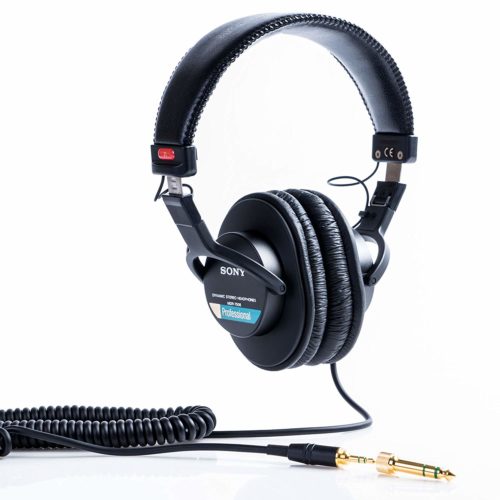
Audio Technica ATH-M50x or M50, M40x
Number one choice for solid, tested and trusted headphones is the Audio Technica ATH-M50x. These are all-round great headphones. The ATH-M50x have solid low-end definition, a good clarity across the frequency range and are generally held in high esteem, considering the price.
They are actually the consumer follow-up to the ATH-M50 – designed for the pros but proved so popular with the general public they decided to make a slightly more “friendly” edition. Although they are essentially the same headphones as far as audio quality goes, word is that the bass response on the ATH-M50x is a little more overdone than on the older ATH-M50. They’ve been tweaked for consumer appeal.
So if you can afford a few extra dollars, then you might find you get a truer sound from the ATH-M50. Having said that Audio Technica say the old model is now discontinued and officially replaced by the ATH-M50x.
Another difference is the detachable cable on the new model. Plus they are foldable, whereas the original ATH-M50 was not. They both have a frequency response of 15 Hz to 28 KHz.
Pros: The highs are detailed and accurate. The mids are good and the bass is tight and deep, without being overwhelming.
Cons: the headphones less “noise-cancelling” than they are “noise-isolating”.
Audio-Technica ATH-M50x on Amazon
If you want to save a few dollars, there’s a cheaper version: the M40x. This version has audio response even more tweaked to the consumer, maybe a little less isolation, but is still a great set of headphones.
There’s really not too much audio difference with either of these 3 sets – whichever one you buy, you won’t go wrong.
(Why do people reviewing audio equipment use the inbuilt camera mic for their review?)
Sennheiser HD-25
Sennheiser rolled these HD-25 out in 1988, pitched them at the film and TV market. The high sound pressure levels and good isolation were key. At some point in the 1990s, DJs started to catch on to them. Turns out, sound engineers and DJs had similar needs for a loud, accurate, isolating and comfortable monitoring.
But, despite their spindly look, they were actually comfortable to wear over long periods of time (especially if you split the headband). Meanwhile, the swivelling cup meant broadcasters could hear some of their own voice.
The sonic character of the HD 25 again emphasises accurate reproduction over a pleasing consumer-oriented sound. For on-the-job monitoring, they hit the mark.
The HD 25 headphones are excellent all around portable headphones for the price and work great for production on the go. And if the film biz doesn’t work out for you, you’ve got your first piece of kit for your DJ career change.
There’s also a more recent HD 25 II version.
You might also want to consider the Sennheiser HD 280 Pro with good noise isolation.
Beyerdynamic DT 770
Great for studio and stage recordings thanks to their pure, high-resolution sound. As I mentioned above regarding the DT100, these Beyerdynamic headphones are built to last. They are great for studio and stage recordings thanks to their pure, high-resolution sound.
They are very comfortable and can be worn for hours at a time, with no problem. The set comes with a pretty long cable, so good for location sound if you need the flexibility. There are different version for different purposes:
- 32 Ohm – for Mobile Devices
- 80 Ohm – for General Studio Use
- DT 770 M – Monitor Headphones
- 250 Ohm – Studio Mixing
beyerdynamic DT 770 PRO on Amazon USA
AKG K240
Heading down the budget range, the AKG K240 are very affordable, while remaining good for critical-listening, semi-open headphones. They are a studio classic – spot the distinctive gold band around the ear cups. Equipment doesn’t get used in recording studios for over 40 years without reason.
The K240 Studios are based on a design first created in 1975, being gradually refined into today’s model. They are comfortable and, being semi-open, are ideal for mixing and feature incredibly detailed and clean mids and highs. Because they are open they have no isolation – which means for location sound they are not going to be keep unwanted background noise out. But for mixing audio for your film at home in a quiet location they’ll be fine.
Other Headphones to Consider
Shure SRH440: mids and highs are rendered with plenty of detail and a nice natural, realistic tone. Built to last and includes thick detachable cable. Maybe not as comfortable as some.
Shure SRH840: clear, crisp, natural-sounding, without going over the top in any frequency range. Very comfortable and foldable, too. Currently double the price of the 440.
Beyerdynamic DT150: an evolution of the DT100 (see above). Solid, durable, ugly, great neutral sound. Excellent spill stoppage and good isolation. Downside: heavy and prone to falling off your head if you’re moving around.
Beyerdynamic DT-150-250 on Amazon
Beyerdynamic DT250: one of the best studio monitors out there due to how flat they are. Closed dynamic 80 ohms headphone. Lightweight compared to DT150. But again can be uncomfortable with long use.
Beyerdynamic DT880: neutral audio with a touch of sharp treble. As with other Beyerdynamic models, built to last. The price has come down on these over the years quite a bit – but only as a result of hot market competition.
Sennheiser HD558: open headphones so offer zero isolation. Superior audio quality providing great sense of depth, width, and separation. More expensive than some other models.
Sennheiser HD650: open back, no isolation. Clear and detailed audio quality, with very natural tonality through bass and mid-range. Very comfortable.
Fostex T50RP MK3: impedance of 50 Ohms, frequency from 15Hz to 35kHz. Semi-open back, but build: rock solid. Designed more for studio or home use.
Read Next: The Kit List
Eager to learn more?
Join our weekly newsletter featuring inspiring stories, no-budget filmmaking tips and comprehensive equipment reviews to help you turn your film projects into reality!
As an Amazon Associate I earn from qualifying purchases.
Simon Horrocks
Simon Horrocks is a screenwriter & filmmaker. His debut feature THIRD CONTACT was shot on a consumer camcorder and premiered at the BFI IMAX in 2013. His shot-on-smartphones sci-fi series SILENT EYE featured on Amazon Prime. He now runs a popular Patreon page which offers online courses for beginners, customised tips and more: www.patreon.com/SilentEye


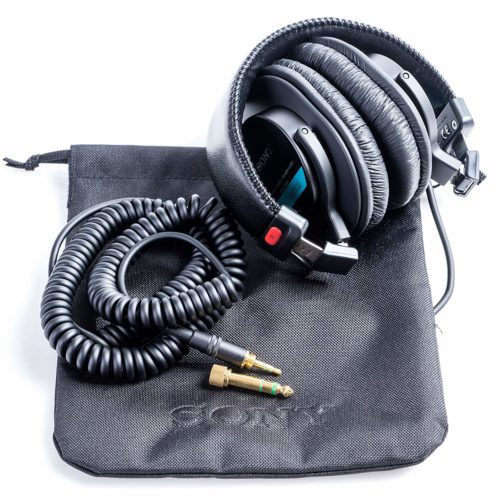
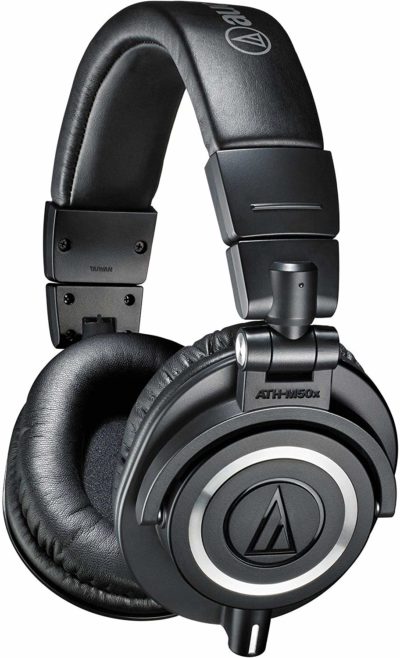

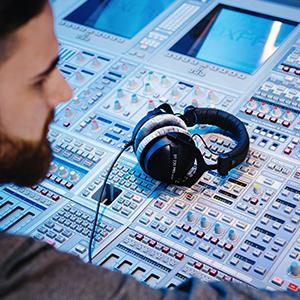
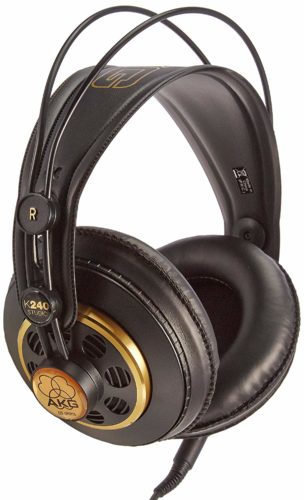
Many people (doctors, colleagues) have told me that i should use in-ears for location recording. I was wondering if that was a good idea or not, let me know what you believe.
I’ve never seen that on a film set
On a film set, you should be able to switch fast. Detecting unwanted sounds, comparing live with mixer sound, etc. And it is important that you’re aware of your surroundings. Not be totally shut-off. I think normal headphones are better suited for this kind of work than in-ears. I recommend Sennheiser HD-25II.